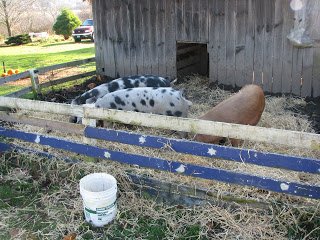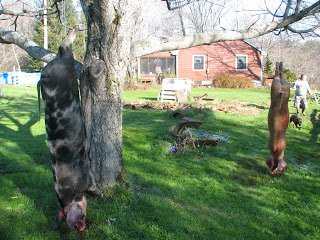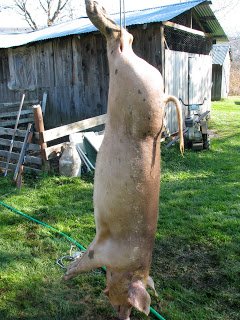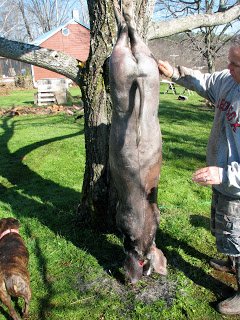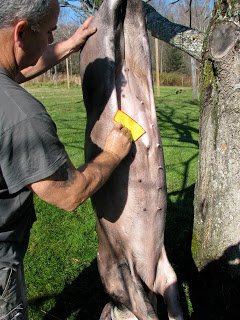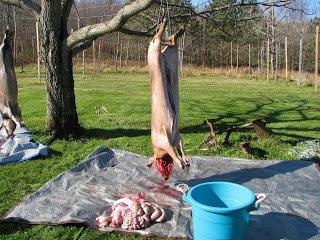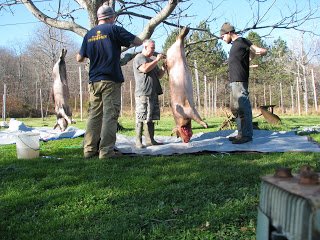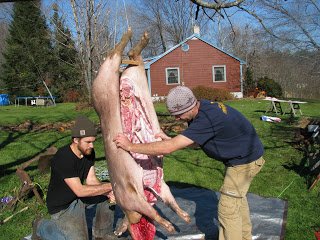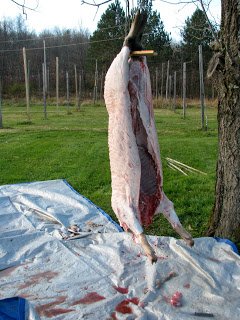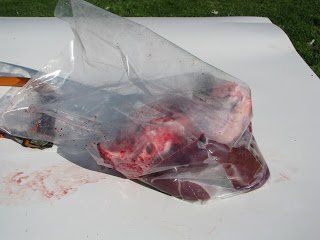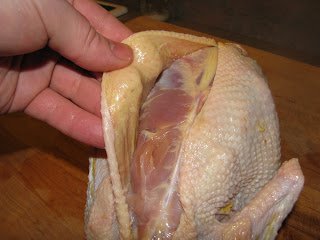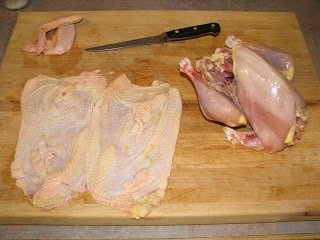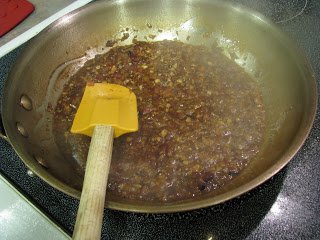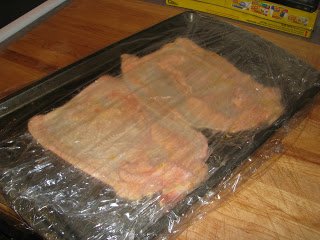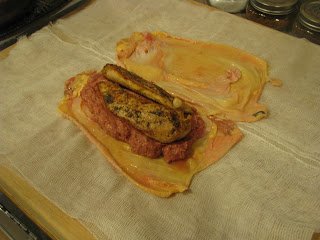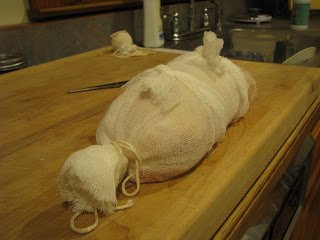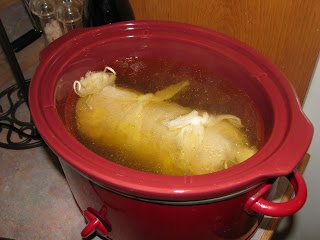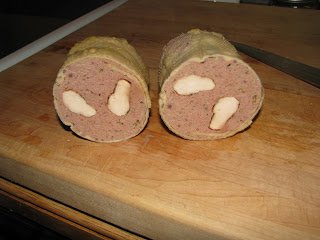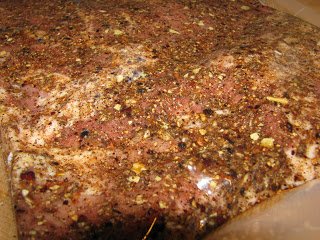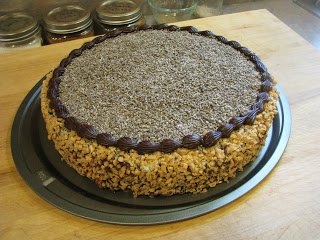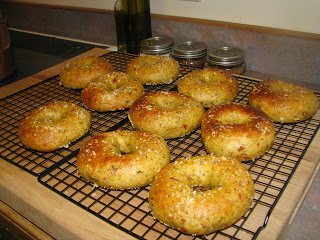A true practitioner of eating sustainable and local, chef Ian Hommel of Vermont, USA, shares with The Yum List, a little on how he got prepared for the winter…
“A cat will look down to a man. A dog will look up to a man. But a pig will look you straight in the eye and see his equal.” Winston Churchill
A few months ago I was preparing myself for a long Vermont winter. The winter can be especially brutal if not prepared properly. My plan was to fill my basement freezer with an abundant supply of hand made local food. Having products like these on hand take some of the sting out of winter. As I’m typing this, the smoker is full and the temperature is hovering at a brisk -8 degrees Fahrenheit. It doesn’t matter where you are from, that’s cold! I have five pounds of cured pork belly smoking away for my later enjoyment. This cut of pork has a story dating back a few months ago…
During the fall I became friends with a local farmer named James. He is the proud owner of Little Bear Farms here in Jericho, and lives right next door. He and I share the same standards in sustainable local products. One morning James called me asking questions about the procedures in breaking down a whole hog. I gave him some important precautions and procedures. That’s when he asked, “It would be great if you could help!” I was out the door with my equipment faster than lightning. Arriving on scene he made the determination to keep one of the female pigs for springtime piglets. James loves his animals. These were the happiest pigs around. Their diet consisted of two pick-up trucks of pumpkins per week and piles of hay. His method of slaughter was extremely humane.
Many farmers have slaughterhouses come pick up their animals for processing. This has a large host of problems associated with it. First, when the animals are picked up, they can sense the change in routine, and become worried and scared in their new environment. I know, it’s sad to think about. The next problem is one of greed on the part of some slaughterhouses. James posed an excellent question; “How do you know that what you’ve sent is what you’re getting back?” He has had a few negative experiences to the point that backyard butchery is the only feasible concept. James was very organized.
Believe me when I tell you that the two pigs died instantly. No lingering, suffering or any nightmare scenarios you read about in corporate farming practices. In one instant, done. I remember the smell of iron was thick in the chilly morning air. To me, this was the soul of the animal. After about thirty minutes it was time to hang the pigs for cooling.
Before getting started, we had to remove the hair from the pigs. The hair and skin of a pig is incredibly durable. Within a few swipes, my carbon steel knife was dull. I had to sharpen my knife every ten minutes. Our goal wasn’t to remove every hair from the animal, but to make the process of breaking the animal down that much easier. This gave us the opportunity to go over the animal inch by inch. This proved to be pretty helpful.
After a quick break, it was time to spray the pigs down with water and use a light bleach solution to sterilize the skin prior to gutting and break down. Again, this gave us time to formulate a game plan to expedite our efforts.
As with the production of any animal, it is very important to not pierce the intestines or any part of the digestive track. One false move can spoil the entire effort. This takes great care and a steady hand. Once complete, the gut sack falls out on its own. This was a huge relief. We now could see our starting point and get really excited about the rest of the afternoon.
Now that the pigs are clean, gutted and split it was time to start skinning. This process was smooth and fast. I had a very sharp flexible boning knife that worked perfectly. This was the last step before breaking the animal down into primal and sub-primal parts.
Working from both sides of the animal we took great care to use every part of the animal. I collected the heart, kidneys, liver and cheeks. These are incredibly delicious and often underused.
The rest of the afternoon went like clockwork. Before we knew it, the job was done. We carefully packed all the meat up and enjoyed a celebratory drink. We all know that the gifts these pigs gave us will be appreciated for months to come. I stuffed my freezer with pancetta, maple bacon, cheeks, shoulders and about five gallons of pig stock. A few weeks ago I had cured pork chops from these animals. You could almost taste a hint of pumpkin in every delicious bite. I am definitely looking forward to next fall!
Along with pigs, James raises chickens and turkeys. A few days ago he dropped off an amazing looking chicken. We got talking about the different preparation methods for chickens when I remembered a true gem. I haven’t had chicken galantine in years. This is another great way to use the whole animal. Essentially, galantine is the whole chicken ground with inlay and stuffed back into its own skin and poached in stock made from it’s bones. If you take your time the process is quite easy. First, skinning a chicken and keeping the skin intact can be a little problematic for some. Use a sharp knife a cut along the spine of the bird. This is your starting point..
With the edge of your knife, work down the inside of the bird. When you come to the leg and wing sections, cut around the bottom joint and remove the skin as you would a tight sweater. keep working till the skin is removed in one piece.
Place the skin on a plastic wrapped baking sheet and place in the freezer. Remove both breasts intact and set aside. Remove the meat off of the legs, thighs and wings. Flip the breasts over and remove the tenderloin. Heat a heavy bottom pan with butter over high heat. Brown the breasts on all sides and set aside to cool. In the same pan add..
1. One Tablespoon Minced Garlic
2. One Tablespoon Minced Shallot
3. One Cup Madeira
Reduce this mixture till almost a paste. Refrigerate this immediately. Combine the leg, thigh, tenderloin, wing and liver into a meat grinder set to the smallest die. Transfer the ground mixture to a food processor and add the Madeira paste, whites of two eggs, salt, pepper and pate spice.
Pate Spice
1. One teaspoon ground cloves
2. One teaspoon ground nutmeg
3.One teaspoon ground ginger
4. One teaspoon ground coriander
5.Two teaspoons cinnamon
6.One Tablespoon ground white pepper
Puree this till smooth. At this time add .75 cup heavy cream. Fold the cream in with a spatula. When you are ready, remove the skin from the fridge and place it on your cutting board
Place half of the mixture lengthwise across the skin and arrange the seared breasts side by side..
Place the other half of the mixture on top of the breasts. Gently roll the galantine so it almost resembles a chicken burrito. Wrap the galantine in cheesecloth and tie off both ends. To add support, tie tow strips of cheesecloth around the center.
Place this in the fridge. Cover the chicken bones with water and proceed to make chicken stock. This is going to be our poaching liquid for the galantine. Ideally, you want to poach this at a temperature between 160-180 degrees F/ 71 to 82 degrees C. To my surprise, my little crock pot held the temperature perfectly. Gently poach this for 45-50 minutes.
Cook to an internal temperature of 160 degrees F/ 71 degrees C. Remove from the heat, cover and chill in the poaching liquid overnight. To serve the galantine, remove from the gelatinous chicken stock, remove the cheesecloth, bring to room temperature and slice thin. This is a very elegant presentation for all occasions.
It pays to take time out our busy lives to make some incredibly delicious food. If possible, make it a habit of bringing the family together to make something outrageous everyone can enjoy. Eat within your means, and eat within your season. Items on this blog are just some of the things packed into my basement freezer. Others include..
Pastrami
Crack Pie
Sun Dried Tomato and Pesto Yeasted Bagels
Happy winter everyone!!
Cheers!


